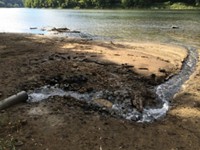Advertisement
Grab your lab coat. Let's get started
Welcome!
Welcome!
Create an account below to get 6 C&EN articles per month, receive newsletters and more - all free.
It seems this is your first time logging in online. Please enter the following information to continue.
As an ACS member you automatically get access to this site. All we need is few more details to create your reading experience.
Not you? Sign in with a different account.
Not you? Sign in with a different account.
ERROR 1
ERROR 1
ERROR 2
ERROR 2
ERROR 2
ERROR 2
ERROR 2
Password and Confirm password must match.
If you have an ACS member number, please enter it here so we can link this account to your membership. (optional)
ERROR 2
ACS values your privacy. By submitting your information, you are gaining access to C&EN and subscribing to our weekly newsletter. We use the information you provide to make your reading experience better, and we will never sell your data to third party members.
Environment
Struggles With Fracking Wastewater
Water used in natural gas production still contains high levels of fracking contaminants even after passing through treatment facilities
by Journal News and Community
March 25, 2013
| A version of this story appeared in
Volume 91, Issue 12
Energy companies that use hydraulic fracturing to extract natural gas use a lot of process water. They’re left with recovered water containing high levels of pollutants, including benzene, bromide, and the heavy metals barium and strontium. The firms can reuse the water, but in some cases they inject it into deep storage wells or send it to local treatment plants. A study has found that water flowing out of treatment facilities still has elevated levels of fracking pollutants (Environ. Sci. Technol., DOI: 10.1021/es301411q). Kyle J. Ferrar and his colleagues at the University of Pittsburgh analyzed water leaving three treatment plants in Pennsylvania before and after the facilities complied with a state request to stop processing fracking wastewater. The team found that levels of contaminants dropped significantly after the plants stopped taking the water. But when the plants still handled it, concentrations of several of the chemicals exceeded EPA drinking water standards. For example, at one facility, strontium levels were on average 48.3 mg/L, which exceeds the 4 mg/L standard. Ferrar says there is no immediate public health concern over the pollutant concentrations, but he thinks the elevated levels could affect aquatic ecosystems downstream of the treatment facilities.




Join the conversation
Contact the reporter
Submit a Letter to the Editor for publication
Engage with us on Twitter